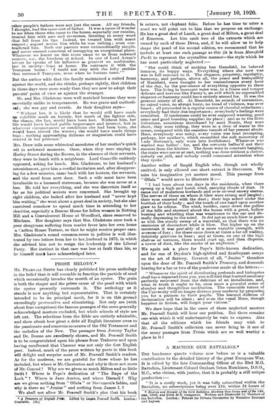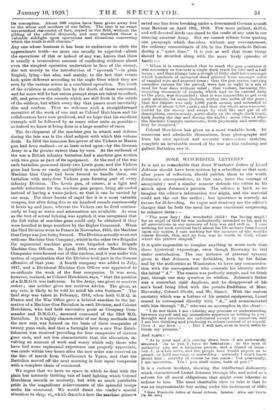A MACHINE GUN BATTALION.*
THE handsome quarto volume now before us is a valuable contribution to the detailed history of the great European' War. It is edited by the late Commanding Officer of the 33rd M.G. Battalion, Lieutenant-Colonel Graham Seton Hutchison, D.S.O., 'M.G., who claims, with justice, that it is probably a still unique production :— " It is a costly work, yet it was fully subscribed within the Battalion, no subscriptions being over 110, within 24 hours of • History and Memoir of the 33rd Battalion Madan* Gun Corps and of the 1Mh, 284h, 100th, and 24815 M.0. Oinspanies. Written and Illnatrated by Members of the Battalion. tendon: Printed for Private Circulation by Waterlow Brothers and Layton.
Its conception. About 600 copies have been given away free to the wives and mothers of our fallen. The text is an exact unvarnished statement of fact, copied in the- field, without the gilding of the official despatch, and may therefore throw a valuable sidelight upon operations and situations concerning which the truth is still obscure."
Any one whose business it has been to endeavour to elicit the approximate truth—no more can usually be expected—about the operations of this or indeed of any war, knows that there is usually a tremendous amount of conflicting evidence about
even the simplest operation undertaken in face of the enemy, due not merely to the introduction of "eyewash "—in plain
English, lying—but also, and mainly, to the fact that events look quite different according to the angle from which they are seen by the various actors in a combined operation. Too much of the evidence is usually lost by the death of those concerned, and far more will be lost unless prompt steps are taken to collect, sift, and preserve the records which are still fresh in the minds of the soldiers, but which every day that passes must inevitably
dim and confuse. Thus we welcome such a straightforward narrative of the work of one unit as Colonel Hutchison and his collaborators have now produced, and we hope that his excellent example will be followed by as many other units as possible—
as indeed we know is being done in a, large number of cases.
The development of the machine gun in attack and defence during the late war is the chief subject with which this volume deals. In 1914 the-immense fire-power of the Vickers or Maxim gun had been realized—or at least acted upon—by the German Army to a far greater extent than by ours. At the outbreak of the war a British infantry battalion had a machine gun section with two guns 88 part of its equipment. At the end of the war each battalion possessed thirty-two Lewis guns, and the Vickers guns had been so vastly multiplied in numbers that a special Machine Gun Corps had been formed to handle them, one battalion with sixty-four Vickers guns forming part of every infantry Division. The Lewis gun, of course, is a light and mobile substitute for the machine gun proper, being Air-cooled instead of having a water-jacket, so that it can be carried by one man. For short bursts of rapid fire it is a most valuable weapon, but after firing five or six hundred rounds continuously it heats up and jams, whereas the Vickers can be fired continu- ously so long as water and ammunition are available. As soon as the test of actual fighting was applied, it wan recognized that the full value of machine guns could only be obtained if they were handled in large numbers by the Higher Command. When the 33rd Division went to France in November, 1915, the Machine Gun Corps was just being formed. The Division actually went out with one Machine Gun Company, whilst in the other two Brigades the regimental machine guns were brigaded under Brigade Machine Gun Officers. In April, 1916, two other Machine Gun Companies were formed out of this nucleus, and it was under this system of organization that the Division took part in the Somme offensive of that year. A fourth company was added in July, 1917, and a Divisional Machine Gun Officer was appointed to co-ordinate the work of the four companies. It was soon, however, realised, as Colonel Hutchison says, "that the position of a D.M.G.O. was ludicrous. In the Army, one gives or receives orders ; one neither gives nor receives advice. The giver, at any rate, is likely to be told to mind his own business." The final step was taken in February, 1918, when both G.H.Q. in France and the War Office gave a belated sanction to the for- mation of a Machine Gun Battalion in each Division, and Colonel Hutchison, who had held successive posts as Company Com- mander and D.M.G.O., assumed command of the 33rd KG. Battalion. It is highly characteristic of our Army methods that
the new unit was formed on the basis of three companies of twenty guns each, Ind that a fortnight later a new War Estab- lishment was received providing for four companies of sixteen guns each, and not less characteristic that the alteration, in-
volving an amount of work and worry which only those who have had some regimental experience can properly appreciate, was made within two hours after the new order was received on the line of march from Westbecourt to Ypres, and that the Battalion moved off the next morning in four equal companies with a complete chain of command.
We regret that we have no space in which to deal with the plain but intensely thrilling tale of hard fighting which Colonel Hutchison records so modestly, but with so much justifiable pride in the magnificent achievements of the splendid troops under his command. We would direct the reader's special attention to chap. vi., which describes how the machine warmers saved our line from breaking under a determined German assault near Meteren on April 12th, 1918. Few more gallant, skilful, and sell-devoted deeds can etand to the credit of any unit in our amazing amateur Army. But we cannot refrain from quoting one paragraph which describes, without any overstatement, the ordinary concomitants of life in the Passchendaele Salient during a "quiet time." It is just as well that these things should be recorded along with the more lively episodes of battle :—
" When it is remembered that to reach the gun positions it was necessary to traverse a single duck track for two and a half hours ; and then plunge into &slough of filthy shell holes amongst which hundreds of unburied dead grinned from amongst miles of tangled wire and stunted trees ; that the gun teams, carrying complete rations for the period, were lost to sight in a sea of mud for four days without relief ; that violent, harassing fire, requiring • thousands of rounds, which had to be carried daily to the guns, was demanded ; that it was impossible to get even pack animals, let alone limbers, within two miles of the guns ; that the Salient was only 1,000 yards across, and extended to a depth of about 3,000 yards; and that the whole area was over- looked by the enemy and swept by shell fire and gas of all descriptions, continuously, particularly on the single duck track, both during the day and during the night ; some idea of what the Machine Gunners underwent, both physically and mentally, may be imagined."
Colonel Hutchison has given us a most readable book. Its numerous and admirable illustrations, from photographs and from his own spirited and accurate water-colour sketches, complete an invaluable record of the war as this enduring and gallant Battalion saw it.



































 Previous page
Previous page